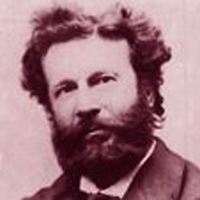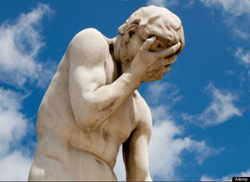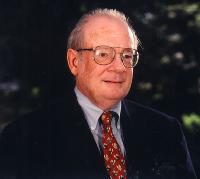|
|
|
 |
Death and the Afterlife: Let us Persevere
Posted on 30 January 2017, 15:53
As a follow-up to my last blog post dealing with philistinism – our tendency to avoid talking about death and to seek a life of pleasure without any search for meaning, thereby leading to existential despair – I am going to let the world-renowned French astronomer Camille Flammarion (below) (1842-1925) have his say on the subject. His words below are extracted and abridged from his 1922 book, Death and Its Mystery: Before Death. Not much seems to have changed in the near hundred years since Flammarion penned his thoughts.

“Whether we face it boldly, or whether we avoid the image of it, Death is the supreme event of Life. To be unwilling to consider it is a bit of childish silliness, as the precipice is before us and as we shall inevitably fall into it some day. To imagine that the problem is insoluble, that we can know nothing about it and shall only be wasting our time if, with daring curiosity, we try to see clearly – that is an excuse dictated by a careless laziness and an unjustified timidity.
“It is hard not to desire an answer to the formidable question that presents itself when we think of our destiny, or when a cruel death has taken from us some one we love. How is it possible not to ask whether or not we shall find each other again, or if the separation is for eternity? Does a Deity or Goodness exist? Do injustice and evil rule over the progress of humanity, with no regard for the feelings that nature has placed in our hearts? And what is this nature itself? Has it a will, an end? Could there be more intelligence, more justice, more goodness, and more inspiration in our infinitesimally small minds that in the great universe? How many questions are associated with the same enigma!
“No thinking man can avoid being troubled in the hours of personal reflection by this question: ‘What will become of me? Shall I die wholly?’
“There is no valid reason for not studying everything, for not submitting everything to the test of positive analysis, and we shall never know anything that we have not learned. If Theology has been mistaken in pretending that [the study of immortality] is reserved for her, Science has been equally mistaken in disdaining them as unworthy or foreign to her mission. The problem of the immortality of the soul has not yet been solved in the affirmative, but neither has it yet been solved in the negative, as has sometimes been pretended.
“It is the general tendency to believe that the solution of the sphinx’s riddle of what lies beyond the grave is out of our reach, and that the human mind has not the power to pierce the mystery. Nevertheless, what subject concerns us more closely, and how can we fail to be interested in our own lot?
“The persistent study of this great problem leads us to believe, to-day, that the mystery of death is less obscure and impenetrable than has been admitted hitherto, and that it may become clear to the mind’s eye by the light of certain actual experiments that were unknown half a century ago. It ought not to surprise us to find psychical research associated with astronomical research. It is the same problem. The physical and moral world are one. Astronomy has always been associated with religion. The errors of that ancient science, which was founded on deceptive appearances, had their inevitable consequences in the erroneous beliefs of former days; the theological heaven must accord with the astronomical heaven under pain of collapse. The duty of all honest men is to seek loyally after truth.
“We once affirmed things of which we were ignorant; we imposed silence upon all seekers. This is what has above all retarded the psychic sciences. Undoubtedly this study is not indispensable to a practical life. Men in general are stupid. Not one out of a hundred of them thinks. They live on the earth without knowing where they are and without having the curiosity even to wonder. They are brutes that eat, drink, enjoy themselves, reproduce their kind, sleep, and are occupied above everything in acquiring money.
“The deplorable conditions of life on our planet, the obligation to eat, the necessities of material existence, explain the indifference to philosophy on the part of the earth’s inhabitants, without entirely excusing them; for millions of men and women find the time to indulge in futile amusements, to read newspapers and novels, to play cards, to occupy themselves with the affairs of others, to pass along the old story of the mote and the beam, to criticize and spy upon those about them, to dabble in politics, to fill the churches and the theaters, to support luxurious shops, to overwork the dressmakers and hatmakers, etc.
“Universal ignorance is the result of that miserable human individualism that is so self-sufficient. The need of living by the spirit is felt by no one, or almost no one. Men who think are the exception. If these [psychical] researches lead us to employ our minds better, to find out what we are here to do, on this earth, we may be satisfied with this work; for truly, our life as human beings seems very obscure.
“The inhabitant of the earth is still so unintelligent, and so bestial that everywhere, even up to the present day, it is still might that makes right and upholds it; the leading statesman of each nation is still the Minister of War, and nine tenths of the financial wealth of the people is consecrated to periodic international butcheries.
“And Death continues to reign over the destinies of humanity! She is indeed the sovereign. Her scepter has never exercised its controlling power with such ferocious and savage violence as in these last years. By mowing down millions of men on the battlefield she has raised millions of questions to be addressed to Destiny. Let us study it, this final end. It is a subject well worthy of our attention.”
In his book, Death and Its Mystery: At the Moment of Death, also published in 1922, Flammarion discusses the strong evidence in favor of survival, stating that much discernment is necessary when examining it, but the cumulative evidence is convincing. He writes:
“There are men who cannot be candid! They would even be afraid to commit themselves by declaring that castor-oil is a laxative. There are limits to skepticism and incredulity. Quibbling and the sophistries of the subtlest dialectic do not affect the existence of fact.
“Unfortunately, as a general thing, people of the upper classes – savants, scholars, artists, writers, judges, priests, physicians, etc. – maintain a discreet reserve, as though afraid to speak out. They are less free, have their own interests to protect, and are silent while others talk. Such faintheartedness, such cowardice, is absolutely despicable. What is there to fear? It is excusable to deny facts through ignorance. But not to dare admit things seen – a sad state of affairs!
“There are other criminals besides those in prisons, namely cultivated men who know truths they do not venture to reveal, for reasons of personal interest, or for fear of ridicule. In the course of my career I have met more than one of these ‘men of science,’ extremely intelligent, very learned, who have been witnesses of metaphysical phenomena beyond cavil, or who have grown aware of them – men who have no doubt of the undeniable existence of these phenomena, yet dare say nothing, through meanness unpardonable in minds of real worth. Or else, from fear of being heard, they whisper, mysteriously, testimony which would be of considerable weight in the triumph of truth. Such men are unworthy of the name of savants. Several of them belong to what is called ‘high society,’ and believe that they would lose credit by seeming over-credulous, although, on the other hand, they subscribe to debatable beliefs.
“A part of the clergy is hostile to [psychical research] and considers that the Church should monopolize such questions. This point of view has come down from biblical times. The summoning of the dead was formally forbidden the Hebrews, and Saul violated his own decrees when he went to consult the witch of Endor and invoked the shade of the prophet Samuel. Perhaps this interdiction was justifiable in the case of incompetent men of the humbler orders, who can so easily fall into the worst stupidities. But in our day to forbid men who are learned, given to reflection, well balanced, to study these problems; to teach that they are not to use the reason God has given them, that they must humble this reason before the affirmations of a debatable divine revelation; to maintain that the question of the nature of the soul and of its survival, which interests so personally each one of us, must be reserved to a caste of casuists who appropriate for themselves the right to judge and to decide between the true and the false, between God and the devil – such is, indeed, a strange way of thinking, and an anachronism carrying us back to the middle ages.
“This error is all the more inexplicable from the fact that the phenomena with which we are concerned support the stories of the sacred Scriptures, among other the apparitions of Jesus, unknown or denied by nine tenths of mankind.
“There are men of worth among the observers: the names of Immanuel Kant, of Goethe, of Schopenhauer, of William Crookes, of Russel Wallace, of Oliver Lodge, of Edison, of Victor Hugo, of Victorien Sardou, of Lombroso, of William James, and of some others, are not negligible; there are observers of all sorts. [However, there are too many] men incapable of being convinced, despite the most evident proofs; worthy men, moreover, from other points of view, learned, agreeable, philanthropic, but whose mental eyes are constructed in such a way that they do not see straight before them. (Hunters tell us it is the same with hares.) Their eyes have a prism before the retina in place of the normal lens, and this prism distorts the rays by a few degrees, with refractions, which differ according to type. This is not their fault. It is not only that they do not wish to perceive the sun at high noon, but they cannot … Eyes are useless to a blind brain, say an Arabian proverb.
“To have too much intellect is sometimes a hindrance to the simple comprehension of things as they are. [In effect], we have against us, in our investigation, three kinds of adversaries, virtually unconquerable: 1) Those who make sport of everything, who are interested in nothing; 2) materialists convinced, on principle, that matter produces everything; 3) human beings confined within a narrow dogma, whatever their religion, sure of their beliefs and satisfied with them. Those with knowledge of truth have always formed a minority, despite the most persevering efforts of free seekers. Let us persevere, however. The good seed will, at length, germinate.”
Michael Tymn is the author of The Afterlife Revealed: What Happens After We Die, Resurrecting Leonora Piper: How Science Discovered the Afterlife, and Dead Men Talking: Afterlife Communication from World War I.
Next blog post: Feb. 13
Read comments or post one of your own
|
 |
Will President Trump make us “One with our Toys”?
Posted on 16 January 2017, 9:21
As the United States prepares for a change of leadership, many people are still scratching their heads and wondering how Donald Trump, a man so seemingly unpresidential, at least in the more traditional or conventional ways, succeeded in the pursuit of the presidency. The media claims that it is due to the anger of the voters – an anger said to be primarily the result of economic struggles by the working class. However, I’m convinced that it goes much deeper than that, and it’s not something that presidents or politicians have much control over or understanding of. It’s really existential despair that is manifesting itself. To overcome this despair, people want change, but they really don’t grasp what that change should involve. In fact, the change they think they want conflicts with the change they really need.

I believe that Giambattista Vico, an 18th-century Italian philosopher, hit the nail squarely on the head when he wrote that men first feel necessity, then look for utility, followed by comfort, then pleasure, and finally luxury, after which they finally go mad – when “each man is thinking of his own private interests.” In that pursuit of pleasure and luxury, there is, according to Vico, a certain social disconnection, which involves moral, intellectual, and spiritual decline.

And that is where we now seem to be. At some point in the pursuit of pleasure and luxury, we became so consumed with our own immediate needs that we lost sight of the larger life. Vico’s “madness” is really despair or hopelessness that results from a void in our spiritual lives. In effect, in striving for greater pleasure and luxury, we became philistines – man striving to be “one with his toys,” while increasingly indifferent to matters of the spirit. “Philistinism tranquilizes itself in the trivial, being equally in despair whether things go well or ill,” the existentialist philosopher Sřren Kierkegaard explained it, going on to say that many philistines don’t actually realize they are in despair, or if they do realize it they don’t understand what they are in despair about. Neither do their psychiatrists, the politicians, or the journalists.
“Despair over the earthly or over something earthly is really despair about the eternal and over oneself, in so far as it is despair,” Kierkegaard offered. This is consistent with what anthropologist Ernest Becker had to say in his 1973 Pulitzer Prize-winning book, The Denial of Death, in which he asserted that death is the mainspring of human activity. “The idea of death, the fear of it, haunts the human animal like nothing else,” Becker said. To free oneself of death anxiety, Becker explained, nearly everyone chooses the path of repression. We bury the anxiety deep in the subconscious and busy ourselves with our jobs, partake of certain pleasures, strut in our new clothes, show off our polished cars, jabber on our phones, hit little white balls into round holes, escape into fictitious stories in books, at the movies, and on television, idolize movie actors and athletes (people pretending to be real people and pretending to be real combatants), experience vicarious thrills at sporting events, pursue material wealth, and seek a mundane security that we expect to continue indefinitely, all the while oblivious to the fact that in the great scheme of things such activities are exceedingly short-term and for the most part meaningless.
As I infer from it all, when we get too much comfort, too much pleasure, too much luxury, as we embrace Epicureanism and hedonism, we begin to wonder what we can strive for next. We begin fiddling as Nero did when Rome burned.
It has been suggested that sowing brings greater happiness than reaping, and we have reaped so much that we have become bored and depressed. Renowned psychiatrist Viktor Frankl referred to it as “mass neurotic syndrome” – the result of an “existential vacuum,” a feeling of emptiness and meaninglessness. The more one seeks pleasure, Frankl observed, the more it eludes him. “Pleasure is, and must remain, a side-effect, or by-product, and is destroyed and spoiled to the degree in which it is made a goal in itself.” A human being, he continued, is not one in pursuit of happiness, but one in search of a reason to become happy. Self-actualization, he further opined, is possible only as a side effect of self-transcendence.
Pioneering psychiatrist Carl Jung wrote that most of his patients were non-believers, those who had lost their faith. They were neurotics. “They seek position, marriage, reputation, outward success or money, and remain unhappy and neurotic even when they have attained what they were seeking,” Jung wrote. “Such people are usually confined within too narrow a spiritual horizon. Their life has not sufficient content, sufficient meaning. If they are enabled to develop into more spacious personalities, the neurosis generally disappears. For that reason the idea of [spiritual] development was always of the highest importance to me.”
Even Sigmund Freud, who was not spiritually inclined, was concerned that one’s attitude toward death has a bearing on his or her psychological health. “Is it not for us to confess that in our civilized attitude toward death, we are once more living psychologically beyond our means, and must reform and give truth its due?” he asked. “Would it not be better to give death the place in actuality and in our thoughts which properly belongs to it, and to yield a little more prominence to that unconscious attitude towards death which we have hitherto so carefully repressed?”
Concomitant with the pursuit of pleasure and luxury is the glorification of the ego and with it a trickle-down narcissism effect. “It’s not necessary for everyone, or even most people, to be narcissistic for materialism to increase in a society,” offer psychologists Jean Twenge and W. Keith Campbell in their book, The Narcissism Epidemic. “Similar to the trends in vanity, narcissistic people begin materialistic trends that raise the standards for everyone else. They show off their possessions and make materialism cool through their charm and outgoing personalities.” Twenge and Campbell cite various studies indicating that young people today are much more focused on “becoming well off financially” than earlier generations. In one study, 93 percent of teenage girls said that shopping is their favorite activity. Can there be any doubt that television and Internet commercials have been the primary instigators in this regard?
If I am interpreting it all correctly, the conscious self wants pleasure and luxury, but the subconscious (the soul) wants peace of mind, and that comes only with seeing this life as a part of a much larger one. Therein is the conflict that goes unrecognized by presidents, politicians, and the press. It is much easier for our politicians and the media to say that people are angry than to say they are in existential despair. If they suggest that people are in such despair, they have to explain what they are in despair over. It would not be politically, journalistically, or scientifically correct to say that their materialistic lifestyles have detracted from their spiritual values and pursuits and that they have lost sight of the larger life. At least it would not be proper for our more left-wing subscribers to suggest such a thing, since it would give recognition to totally unscientific ideas. If the more right-wingers were to suggest it, it would be seen as nothing more than religious fundamentalism and folly. It is so much simpler to blame it on anger over economic deprivations and social injustices than to say it results from the pursuit of pleasure and luxury, the very things we think we want.
It seems very unlikely, therefore, that President Trump will get us back on the right track.
Next blog post: January 30
Michael Tymn is the author of The Afterlife Revealed: What Happens After We Die, Resurrecting Leonora Piper: How Science Discovered the Afterlife, and Dead Men Talking: Afterlife Communication from World War I.
Read comments or post one of your own
|
 |
“Soul Mist” – the Most Popular Subject
Posted on 02 January 2017, 11:05
Of the 160 posts at this blog since it moved to White Crow in April 2010 after several years at another site, the one with the most views was posted on October 4, 2010 and is titled “Strange Deathbed Mist and Light Explained.” The subject was also dealt with in my post of June 11, 2012 (click here and scroll down). Based on the comments left at the two posts, I gather that people who have experienced something mysterious at deathbeds begin searching the Internet for some explanation and find their way to those posts, especially that of 2010. A number of them have told of their experience in the comments section.
As discussed in those two previous blog posts, many people have observed a strange mist over a deathbed, often at the time the person departs the physical body. “Some say that it looks like smoke, while others say it is as subtle as steam,” Dr. Raymond Moody (below) wrote in his 2010 book, Glimpses of Eternity. “Sometimes it seems to have a human shape. Whatever the case, it usually drifts upward and always disappears quickly.” Moody also wrote of people seeing unusual light in the room.

In their excellent 2008 book, The Art of Dying, Dr. Peter Fenwick, a renowned British neuropsychiatrist, and Elizabeth Fenwick also discuss the “smoke,” “grey mist,” or “white mist” which leaves the body at death. “Sometimes it will hover above the body before rising to disappear through the ceiling, and it is often associated with love, light, compassion, purity, and occasionally with heavenly music,” they write, adding that not everyone who is in the room sees it.
In his 1970 book, Out of the Body Experiences, Dr. Robert Crookall quotes Dr. R. B. Hout, a physician, who was present at the death of his aunt. “My attention was called…to something immediately above the physical body, suspended in the atmosphere about two feet above the bed. At first I could distinguish nothing more than a vague outline of a hazy, fog-like substance. There seemed to be only a mist held suspended, motionless. But, as I looked, very gradually there grew into my sight a denser, more solid, condensation of this inexplicable vapor. Then I was astonished to see definite outlines presenting themselves, and soon I saw this fog-like substance was a assuming a human form.”
Such misty vapors and “lights” around the deathbed have been reported by other researchers, including Dr. Bernard Laubscher, a South African psychiatrist. “I was told by different ‘Tant Sannies’ (caregivers) how while watching at the bedside of the dying one with one or two candles burning they had seen the formation of a faint vaporous body, an elongated whitish purplish-like cloud; parallel with the dying person and about two feet above the body,” Laubscher wrote in a 1975 book, Beyond Life’s Curtain. “Gradually this cloudlike appearance became denser and took on the form, first vaguely and then more definitely, of the person in the bed. This process continued until the phantom suspended above the body was an absolute replica of the person, especially the face.”
As Laubscher came to understand it, the vaporous material has the same makeup as ectoplasm, the mysterious substance given off by physical mediums before materializations. It acts as sort of a “glue” in bonding the physical body with the spirit body, and the more materialistic a person the denser the ectoplasm and the more difficulty the person has in “giving up the ghost.” Ectoplasm has also been referred to as teleplasm, psychoplasm and psychic force.
Soul mist and ectoplasm may very well be the same thing that German chemist Baron Karl von Reichenbach (1788-1869) called odic force, or just od, or odyle. As I discussed in the November/December issue of Atlantis Rising magazine, it may have been the most important discovery in the history of mankind – a “life principle” that permeates all living things. It has been likened to the prana of the ancient Hindus, the vis medicatrix naturae of Hippocrates, the mana of Polynesian culture, the chi of the Chinese, the astral light of the Kabbalists, the telesma of Hermes Trismegistus, the magnetic fluid of Mesmer, and the orogone energy of Reich.
While Reichenbach was well respected in the scientific world, having discovered paraffin and creosote, and was considered one of the world’s foremost authorities on the subject of meteorites, his findings on od were rejected, even ridiculed, by mainstream science when first published in 1845, and they are forgotten or ignored today.
Reichenbach’s research involved studying a number of “sensitives” – people who today might be called clairvoyants or clairsentients – it did not include any kind of “spirit” intervention. It focused on “mind-over-matter” tasks, such as identifying objects in a dark room, dowsing for water in an open field, and moving the needle of a compass without touching it – activities outside the normal five senses and in defiance of known science, what modern-day parapsychologists refer to as extra-sensory perception or ESP.
If soul mist, ectoplasm, and odic force are, in fact, one and the same thing or are related, they take on, as Moody reported, various densities – from a misty vapor to a foamy or slimy substance looking like shaving soap – flowing from one of the orifices of a so-called “medium” in an entranced state – from the mouth, ears, nostrils, vagina and even the pores. Some of the photos show what are claimed to be materialized human forms – occasionally just a face or an arm – forming within the ectoplasm.
If we are to believe the debunkers and skeptics, ectoplasm is nothing more than cheesecloth stuffed into one or more of the cavities of the body and then regurgitated at an opportune time, the sole purpose being to dupe those present. However, it is difficult to imagine cheesecloth being stuffed into the pores of the skin or in the nostrils or ears and then extruded from those orifices, then flowing on the floor. (See photo of ectoplasm flowing from medium Kathleen Goligher as photographed by Dr. William J. Crawford, below).

It was Professor Charles Richet, the Nobel Prize in medicine in 1913 for his research on anaphylaxis, the sensitivity of the body to alien protein substance, who gave the name “ectoplasm” (exteriorized plasma) to the substance. “The word ‘ectoplasm,’ which I invented for the experiments with Eusapia (Paladino), seems entirely justified,” he wrote, explaining that it is a kind of gelatinous protoplasm, formless at first, that exudes from the body of the medium, and takes form later. “In the early stages there are always white veils and milky patches and the faces, fingers, and drawings are formed little by little in the midst of this kind of gelatinous paste that resembles moist and sticky muslin.”
Richet mentioned that there are stages in the materialization process. “[First,] a whitish steam, perhaps luminous, taking the shape of gauze or muslin, in which there develops a hand or an arm that gradually gains consistency. This ectoplasm makes personal movements. It creeps, rises from the ground, and puts forth tentacles like an amoeba. It is not always connected with the body of the medium but usually emanates from her, and is connected with her.” The flat materializations, which skeptics pointed to as obvious evidence of fraud, came, Richet explained, in the rudimentary phase, a sort of rough draft in the phase of building up.
That ectoplasm is a scientific fact, Richet had no doubt, though he called it “absurd.” “Spiritualists have blamed me for using this word ‘absurd’ and have not been able to understand that to admit the reality of these phenomena was to me an actual pain,” he explained his position. “But to ask a physiologist, a physicist, or a chemist to admit that a form that has a circulation of blood, warmth, and muscles, that exhales carbonic acid, has weight, speaks, and thinks, can issue from a human body is to ask of him an intellectual effort that is really painful. Yes, it is absurd, but no matter – it is true.”
A century after Richet’s discoveries, mainstream science still laughs at it all. How sad!
Next blog post: January 16
Michael Tymn is the author of The Afterlife Revealed: What Happens After We Die, Resurrecting Leonora Piper: How Science Discovered the Afterlife, and Dead Men Talking: Afterlife Communication from World War I.
Read comments or post one of your own
|
|
|
|